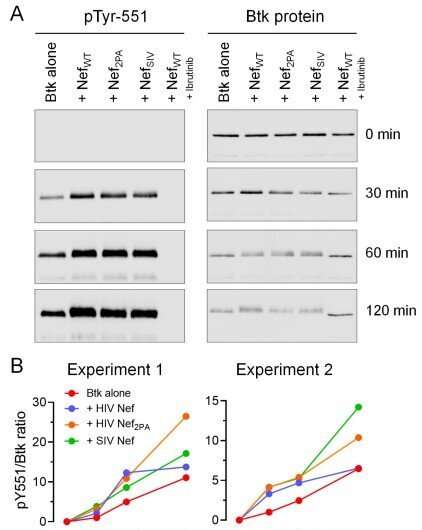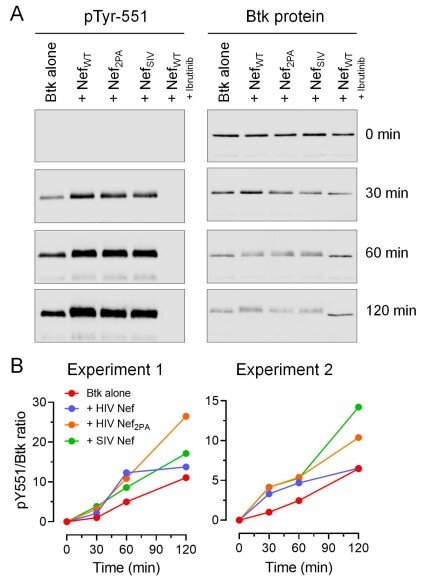
More than 40 years into the HIV pandemic, scientists are still turning up clues revealing how the virus hijacks its host’s cellular processes to support its own replication—and promote the long-term survival of the virus itself.
A new study, led by researchers at the University of Pittsburgh, has identified how an HIV protein called Nef activates enzyme activity in host cells necessary for the virus to replicate.
While it might seem that at least by now scientists would have unraveled the many mysteries underlying the HIV infection process, the new research is testimony to the complexity of a virus that has killed more than 40 million people since the early 1980s, and still eludes a cure.
“Viruses ensure successful replication, in part, by subverting host signaling pathways,” writes Dr. Manish Aryal of the Department of Microbiology and Molecular Genetics at the University of Pittburgh’s School of Medicine. “The Nef protein produced by the viruses HIV-1 and SIV [simian immunodeficiency virus] drives efficient viral replication partially by inducing constitutive activation of host cell tyrosine kinases.”
HIV-1 is the pathogen that causes AIDS and continues to fuel the ongoing worldwide pandemic. SIV is a related infectious agent that infects non-human primates.
Tyrosine kinases, meanwhile, are enzymes that are vital to the function of cells, especially as signaling molecules involved in the intricate messaging that occurs throughout cells. There are entire families of tyrosine kinases, one of which is the Tec family. These kinases are involved in intracellular signaling mechanisms of cytokine receptors, G-protein-coupled receptors, lymphocyte surface antigens, and integrin molecules. They are also key players in the regulation of immune cell functions.
The Src family is another group of tyrosine kinases. Members are non-receptor tyrosine kinases and are generally cell membrane-associated and act as key signaling intermediaries, regulating such processes as cell differentiation, proliferation, migration, metabolism and apoptosis.
Overall, tyrosine kinases can transfer a phosphate group from the energy molecule adenosine triphosphate—ATP—to the tyrosine residues of specific proteins inside cells. They are additionally important regardless of which family because they act as “on” and “off” switches in a multitude of cellular functions. Because of their ubiquity and importance to cell function, HIV has found a way to circumvent tyrosine kinases to its own reproductive advantage.
Writing in the journal Science Signaling, the Pittsburgh team, collaborating with researchers from the University of Iowa, uncovered how HIV’s Nef protein activates the enzyme Btk [Bruton tyrosine kinase], which is critical for HIV replication. Nef promotes structural changes in Btk, which effectively puts the enzyme under HIV’s control. It accomplishes this task by stabilizing an intermolecular complex known as the SH3-SH2 domain. Upon stabilizing this domain the Btk enzyme is under HIV’s control and performs tasks that benefit the virus, not the host’s cells.
The mechanism involved in the HIV-Btk interaction is distinct from how Btk is activated in healthy cells. HIV’s Nef protein also has a separate playbook to activate enzymes of the Src family. But the take home message here is this: The HIV-Btk interaction constitutes a previously unrecognized mode of Tec family enzyme regulation and indicates that HIV’s Nef protein can induce tyrosine kinase activation through independent mechanisms.
“HIV-1’s Nef protein evolved distinct mechanisms to activate Src and Tec family tyrosine kinases to enhance viral replication,” Aryal noted.
Although the findings break new scientific ground, they underscore a deceptively simple point: Generally speaking, it has taken millions of years of evolution for viruses to perfect their skills to overtake the molecular mechanisms of cells. It is a painstaking enterprise for researchers like Aryal and others to decipher the plethora of dirty tricks viruses use to sustain themselves and prosper as pathogens. The Pittsburgh-led research adds to a growing catalog of HIV data that has increased over the past 40 years—and is growing still.
HIV, the human immunodeficiency virus, is a retrovirus whose genetic material is composed of RNA. And because it is defined a retrovirus that means HIV is equipped with an enzyme called reverse transcriptase, or RNA-dependent DNA polymerase. The enzyme enables the virus to transform its RNA into DNA by synthesizing a double helix of DNA via reverse transcriptase. The devious virus, almost like magic, makes its genetic material like that of its host: double stranded DNA.
This extraordinary feature allows the virus to make a multitude of copies of itself in host cells. As remarkable as that feat may seem, it isn’t the only molecular characteristic of HIV that has made it a global infectious menace. The virus can hide out in a latency period that can last for years. So its ability to manipulate tyrosine kinase, as Aryal and colleagues have found, should come as no surprise.
Source: Read Full Article
